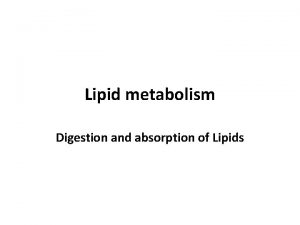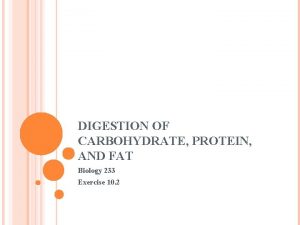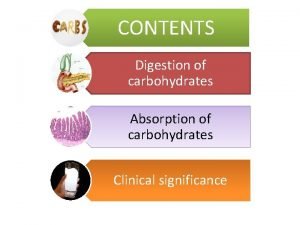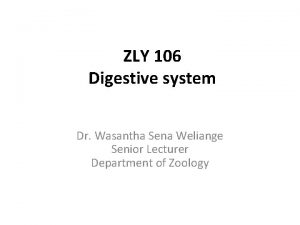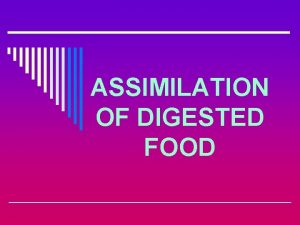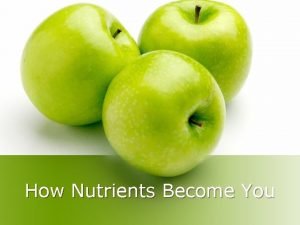Nutrients Food is eaten and digested in the





- Slides: 5

Nutrients Food is eaten and digested in the body to allow the absorption of energy and nutrients. There are two different types of nutrients: • macronutrients; • micronutrients. There are three macronutrients that are essential for health. These are: • carbohydrate; • protein; • fat. Macronutrients are measured in grams (g).

Carbohydrate The two types of carbohydrate that provide dietary energy are starch and sugars. Dietary fibre is also a type of carbohydrate which is not digested to provide energy. Starchy carbohydrate is an important source of energy. 1 gram of carbohydrate provides 4 kcal (17 k. J). Structure of carbohydrate All types of carbohydrate are compounds of carbon, hydrogen and oxygen. They can be classified in many different ways. One common way is according to their structure. Sugars come from a variety of foods. Some are within the cellular structure of the food, e. g. in fruit or vegetables. These are called intrinsic sugars. Other sugars are not bound into the cellular structure of the food, e. g. in milk or honey. These are called extrinsic sugars. Can you give some examples of sources of sugar in the diet? • Fruit and vegetables (fructose) • Milk and dairy products (lactose) • Honey • Fruit juice • Table sugar (sucrose) • Sweets and chocolate Starchy carbohydrate Starch is found in a variety of foods. It is a complex carbohydrate. Can you give some examples of sources of starch in the diet? • Potatoes • Bread • Rice • Pasta Cereal and cereal products are the main source of carbohydrate for adults in Britain.

Protein is essential for growth and repair and keeping cells healthy. Protein also provides energy: 1 gram of protein provides 4 kcal (17 k. J). Structure of protein Protein is made up of building blocks called amino acids. Different foods contain different amounts and different combinations of amino acids. Foods containing all essential amino acids are High Biological Value (HBV). Protein from animal sources (e. g. meat, fish, eggs and dairy products) contains the full range of essential amino acids needed by the body. Soya and Quorn also contain all essential amino acids. Foods missing one or more essential amino acid are Low Biological Value (LBV). Protein from plant sources (e. g. pulses and cereals) typically contain fewer essential amino acids. Sources of protein Animal: • meat and poultry; • fish; • eggs; • milk; • cheese. Plant: • nuts; • seeds; • pulses, e. g. beans, lentils; • Quorn (mycoprotein); • soya products. Eating different types of protein can ensure sufficient intake of essential amino acids which are needed by the body. Can you think of dishes which combine protein from different sources? For example: • Baked beans on wholegrain toast • Hummus and salad wrap • Fish pie and peas • Spinach and chickpea curry with rice

Fat provides fat-soluble vitamins A, D, E and K, and is necessary for their absorption. It is also important for essential fatty acids the body cannot make. Fat provides a concentrated source of energy: 1 gram of fat provides 9 kcal (37 k. J). Foods that contain a lot of fat provide a lot of energy. Structure of fat Fat is made up of different types of fatty acids and glycerol. The structure of the fatty acids determines: • their effect on our health; • their characteristics, e. g. melting point. Structure of fat Depending on their chemical structure, fatty acids are usually classified as: • saturated; • monounsaturated; • polyunsaturated. High intakes of saturated fat may raise blood cholesterol and increase the risk of heart disease and stroke. A diet high in unsaturated fat is associated with a lower level of blood cholesterol and reduces the risk of heart disease. All foods provide different types of fatty acids in varying proportions. Butter is often described as a ‘saturated fat’ because it has more saturated fatty acids than unsaturated fatty acids. Most vegetable oils are described as ‘unsaturated fats’ as they have more mono- and polyunsaturated fatty acids than saturated. Most saturated fats are solid at room temperature and tend to come from animal sources. Most unsaturated fats are liquid at room temperature and are usually from plant sources.

This table shows sources of fat in the British diet. Type of fat Total fat Source Meat and meat products (23%) Cereals/cereal products (incl. cakes and biscuits) (19%) Milk and milk products (14%) Fat spreads (12%) Potatoes and savoury snacks (10%) Eggs and fish (7%) Saturated fat Milk & milk product (24%) Meat & meat products (22%) Cereal products (18%) Fat spreads (11%) Fried potatoes/savoury snacks (6%) Eggs & egg dishes (3%) Unsaturated fat Meat & meat products (27%) Cereal products (17%) Potatoes cooked in oil & savoury snacks (12%) Fat & spreads (11%) Milk & milk products (10%)

